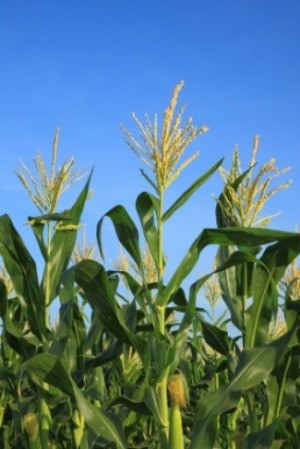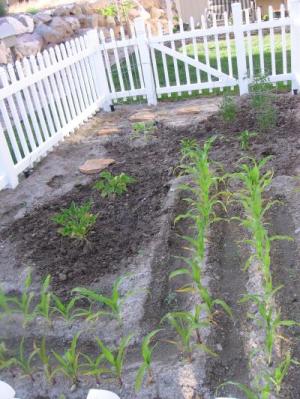
This page contains the following solutions.
Did you know, for every potential kernel of corn, there is a corn silk? A grain of pollen from the tassel must fall on each silk and travel down the silk tube to the corn ovule (where fertilization occurs) in order for there to be a fully developed ear of corn.
I planted corn seeds in this 8x8 foot raised bed. When they came up, I thinned to 64 plants. So there was about one plant per square foot.
Summer just wouldn't be the same without eating juicy, sweet, corn-on-the-cob. Selecting and growing a corn variety that gives you the sweet flavor you're looking for can be a bit confusing unless you're able to sort through some names and abbreviations.
Choose a sweet fast growing corn, 1 or 2 varieties. Make a large square area to plant the corn in. Do not plant in rows but in lines to fill up the square and put 3 seeds in each hole.
Here are the questions asked by community members. Read on to see the answers provided by the ThriftyFun community.
Hardiness Zone: 5a
Pakjc from kentland, Indiana
A: Hi Pakjc,
Corn and Zucchini are both heavy nitrogen feeders, so if you are not rotating the location of your vegetables yearly, past crops may have depleted the nitrogen out of the soil. Even if you're using compost, it may not have contained enough nitrogen or it may simply not have had enough time to add nutrients to your soil. Beans fix nitrogen, which is exactly what corn and zucchini need a lot of. Try rotating your beans with your zucchini and corn by planting your corn and zucchini where your beans were last year and see what happens.
Ellen
Do you rotate when you plant ? Add some compost to your garden and add some compost to the rows when you plant.You do have a compost pile ???? :-) compost is great for all plants ,even your potted and house plants. Call your local garden center and ask them what the problem is, they can help a lot . hope this helps
it sounds like maybe your seeds were bad. if they don't grow again this year, then you will know it is the soil. good luck.
Make sure you rotate your crops. Just like farmers, here they rotate corn with soybeans. Corn takes out a lot of nutrients from the soil. I agree with Rosa, rotate and add nutrients. After 5 years, your plants have used up everything so keep it going with fertilizer or compost.
Corn is a heavy feeder. I rotate it with beans, allowing at least two years between corn plantings in the same spot. Lots of compost for everything. Ask your county extension agent and the local Master Gardeners chapter for clues.
I have just planted some corn which are atleast 10 inches high, they have been ok untill today. Some of the leaves have gone brown and slightly whilted ?
can anyone help ?
Some of my corn stalks are approx. 10-12 inches others are much shorter. They all seem to be yellowing and not growing like they did initially.

I, like the guy before me, have had problems when growing corn. Six years ago I had plants about 8 feet tall and the corn was very sweet. Since then the plants have only got 3 ft tall the corn cob has only reached the lenght of 3"
The canes are extremely small. I have added the basic 10 10 10 10 I put all sorts of vegetable peels banana, ect. I took the plants over to a nursery and even that guy just scratched his head. HELP
I, like the guy before me, have had problems when growing corn. Six years ago I had plants about 8 feet tall and the corn was very sweet. Since then the plants have only got 3 ft tall the corn cob has only reached the length of 3"
For the first time I have planted a few corn plants, is it necessary to detassel, or can you leave the tassels on and still get corn?
By jim
The tassles are a necessary part of fertilization process. You should also plant corn in a block, ie say 4 rows by 4-6 in a row, to help fertilize.
You need to leave those tassels (also known as 'silks') on the new ears for a number of reasons including as a way to know when the ears are ready to harvest.
Count 21 days from the first appearance of the tassels to know when your corn is ready:)
The tassels are at the top of the plant. They send pollen down to the silk that grows from the ears of corn. The silk catches the pollen to pollinate the corn rows on each cob. Removing either the tassels or the silk will not allow the pollination process to form corn rows on the cobs. Leave both intact.
How do I get rid of spiders and ants on my corn stalks?
By Betty
To get rid of ants, locate the hills (colonies) and use outdoor ant baits. If you kill the ants at the source they won't bother your corn. I don't see why you'd want to get rid of the spiders, because they kill the pest bugs that would otherwise destroy your corn.
To be safe, though, you can wear long sleeves and gloves when you pick the corn and tuck your pants into your socks, then shake out your clothes when you get inside. Spiders are hard to kill, and any pesticide strong enough to kill them is certainly something you don't want to be ingesting.
You might also consider building and hanging bird boxes next year. Birds eat spiders and ants, so the more birds the better.
I would like to know when to plant corn seeds and how deep in the dirt to plant them.
By Dale
Corn/ sweet. Do not save seed. Make at least four plantings, beginning in March. Plant 2 to 3 weeks apart. Plant three seeds to a hill 12 inches apart and thin to one stalk per hill. Fertilize heavily. Do not pull suckers
Here is a great website for you hope this helps.
My husband always uses an old saying 'plant corn when the oak leaves are as big as a squirrels ear'. It is always funny to hear him say it, but it seems to work.
Which crop is used for the intercropping in a maize field?
Beans and gourds can be grown with maize, beans provide nitrogen to the two others plants, beans climb up the maize and gourd provides shade at the foot of the two others which will then need less watering. The shadow provided by the gourd will also prevent the growing of unwanted weeds.
When the maize reaches 6 inches put 3 beans of climbing beans around each maize a week later saw one gourd.
In France we call these three plants the three sisters.
Hope this helps !
Catherine
I would like to know how to grow corn at home. Also there are 3 pods on the plant. How long will it be before it gives a crop to harvest?
By radder
Corn takes a long time to grow. I surround mine with chicken wire on the sides and top so birds and animals dont eat it before I do.
Hardiness Zone: 5a
Jan from Saratoga Springs, NY
Weed seeds are well adapted to surviving conditions that corn kernels are not, so it's no surprise you're able to grow a bumper crop, especially now that they have a shot of fertilizer. Here are a few possible reasons your corn seeds failed to germinate:
Ellen
Is it this years seed corn? If it's old it won't sprout. You are watering, aren't you? Maybe you need to wait a bit longer...dig up a seed or two and see if it's sprouting.
We are growing 16 corn plants in an earthbox. I don't know what to expect. Right now, the plants are at different heights 4-5 feet, but gangly and a pale green. Flower stalks have formed, but I am wondering when and if they will form corn with the silk tassels, and if I am giving it too much water. Today, I plan to give it a sea weed drink. What do you think?
Hardiness Zone: 9a
Annie from Sacramento
Ellen
You are certainly doing okay with an earthbox but corn must have 2 things--lot's of SUN and tremendous amounts of FERTILIZER. I have been too sick to have a large garden so I planted 18 corn plants in a small raised bed. But I had to purchase the young plants and transplant them. They were light colored and sickly looking until I started giving them Fish Emulsian fertilizer each day. I will give them this food dose each day until they are healthier. The tassles will form, but if there is not enough wind or birds to spread the pollen, you can tkae your hand and shake the tassles on each other to pollinate.